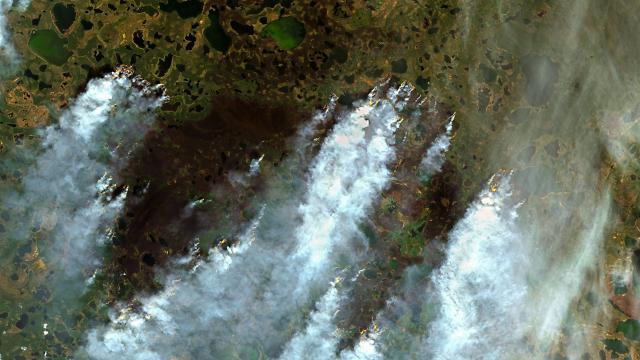The wildfire crisis in Siberia continues unabated. This year’s blazes have smashed records, including the northernmost fires on record and the highest total of Siberian carbon emissions. If you want to know what a climate emergency looks like, this is it.
Fire season in Siberia relentless heat that has cooked the region. Siberia has been the most abnormally hot place on Earth all year, and continued pulses of heat are expected to ripple across the region through at least mid-July. Remote fires have been nearly impossible to control and monitor. The coronavirus has made matters worse, with people escaping from cities and starting fires and firefighters struggling to socially distance while battling blazes.
As a result of the widespread fire activity, the region has sent carbon streaming into the atmosphere. Mark Parrington, a senior scientist studying fires with the European Centre for Medium-Range Weather Forecasts, tweeted that June 2020 saw the highest level of carbon emissions from Siberian fires on record, with an estimated 59 megatons of carbon dioxide released into the atmosphere. That broke the record set [checks notes] last year amid a catastrophic fire season and is roughly equivalent to the entire annual emissions of Portugal.
“Just based on the fire data, we had seen some increasing yearly activity in the Arctic Circle between 2015 and 2018, but the last two years have been a lot higher than in those years,” Parrington told Gizmodo in a Twitter direct message.
The fires aren’t just burning forest (though they are doing that). They’re also burning through the tundra north of the Arctic Circle. Satellites captured a fire that ignited just 48 km from the Arctic Ocean, making it the northernmost fire ever spotted, according to satellite expert Annamarie Luongo.
The fact that fires are burning in the tundra is a huge cause for concern, because the area contains vast stores of carbon-rich landscapes that include peatlands and frozen (for now) soil known as permafrost. Fires have been known to overwinter in peatlands, smouldering underground only to explode in the spring and summer. At least some of the fires in Siberia have done that. The fires near permafrost could be even more worrying, though, which is saying a lot.
A long smoke plume from #Siberia #wildfires was predicted to reach the North Pole in forecasts of aerosol optical depth & total column carbon monoxide initialized at 00z on 1 July 2020 from the #Copernicus Atmosphere Monitoring Service https://t.co/rZyxBH5Ae7 #ArcticFires pic.twitter.com/5Q3upD31Cl
— Mark Parrington (@m_parrington) July 2, 2020
“The thawing of permafrost is increasing the potential fuel loading for fires,” Thomas Smith, a fire expert at the London School of Economics, told Gizmodo in an email. “I have a new dataset from [the National Snow and Ice Data Centre] that also confirms that many of these fires are burning on supposedly “˜continuous permafrost extent with high ground ice content.’
“Given that this ground should be frozen or at least boggy all year round, it should not be available to burn! But it is burning, which implies that it has thawed out and has dried.”
The fires could set off a nasty feedback loop by releasing carbon that warms the planet, which in turns makes fires and thawing permafrost more likely. It’s one of the feedback loops that poses the greatest risk to the climate while permanently altering the northern landscape.
If you’re like me, it’s easy to look at what’s happening in Siberia right now and wonder if we’re passing a tipping point. If you’re a scientist, it’s easy to look at the situation and say we need more data. Smith told me it’s too early to tell, as did Jessica McCarty, a fire expert at Miami University, Ohio, who told Gizmodo in an email that “tipping points are likely to be complex feedback loops.”
What is clear, though, is that we’re getting a preview of what the future holds for the region, particularly if the world doesn’t curb its carbon emissions. McCarty said modelling indicates that the types of fire seasons we’ve seen the last two years ” earlier starts and more intense fires ” are what we could expect to become the norm in the next 30 or so years.
“If next year and the year after, the fire season in Siberia again starts at the end of April for the boreal and beginning of May for the Arctic, then this aligns with mid-century predictions,” she said.
In other words, if this isn’t the future that world leaders want, then they need to act now to stave off catastrophe.
